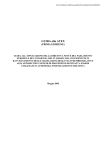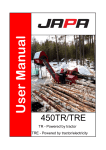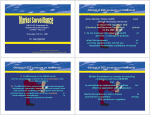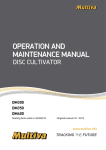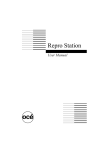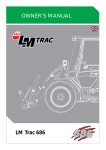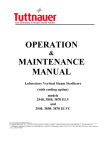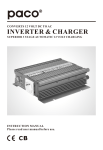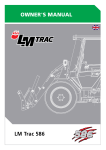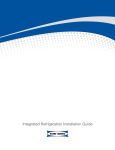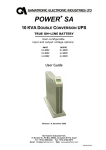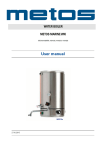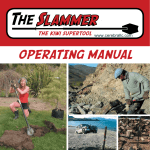Download User Man ual - Four Seasons Fuel
Transcript
User Manual 700TR/TRE TR – Tractor-driven TRE – Tractor/electricity-driven TABLE OF CONTENTS 1. 2. Overview ................................................................................................................................................................ 2 1.1 Intended use of the machine .......................................................................................................................... 2 1.2 Declaration of Conformity............................................................................................................................... 3 1.3 Warnings and other markings affixed to the machine ..................................................................................... 4 1.4 Nameplates of the machine ........................................................................................................................... 5 1.5 Machine models............................................................................................................................................. 6 1.6 Safety regulations .......................................................................................................................................... 6 1.7 Sound level and vibration ............................................................................................................................... 7 1.8 Responsibility of the operator ......................................................................................................................... 7 1.9 Working conditions ........................................................................................................................................ 7 1.10 Warranty terms .............................................................................................................................................. 7 Inspection and installation of the machine ........................................................................................................ 10 2.1 3. 2.2 Main parts of the machine (2) ...................................................................................................................... 10 2.3 Lifting and transporting the machine (2) ....................................................................................................... 10 2.4 Electric motor (3) ......................................................................................................................................... 11 2.5 The work and transport positions of the discharge conveyor ........................................................................ 11 2.6 Bringing the in-feed deck into the work position (7, 8 and 9) ........................................................................ 12 2.7 Bringing the in-feed deck into the transport position, (7, 8 and 9) ................................................................. 12 2.8 Checking the hydraulic oil level and topping up the oil (10) .......................................................................... 12 2.9 Connecting to the tractor or to the electric motor .......................................................................................... 13 2.10 Emergency stopping of the machine (13) ..................................................................................................... 14 Functions of the firewood processor ................................................................................................................. 15 3.1 4. 6. Preparations before starting the work:.......................................................................................................... 15 3.2 Adjusting the log length (14) ........................................................................................................................ 15 3.3 Feeding the log to the blade (15, 16, 17) for cutting ..................................................................................... 15 3.4 Starting up the hydraulic splitting (18) .......................................................................................................... 15 3.5 Adjusting the height of the splitting wedge (19) ............................................................................................ 15 3.6 Swinging the discharge conveyor and tightening its belt (20) ....................................................................... 16 3.7 Discharge conveyor hydraulics (21.22) ........................................................................................................ 16 3.8 Replacing the crosscut blade (23.24) ........................................................................................................... 16 The splitting mechanism and how to adjust it ................................................................................................... 17 4.1 5. Delivery inspection of the machine ............................................................................................................... 10 Splitting mechanism (25,26)......................................................................................................................... 17 4.2 Adjusting the splitting mechanism (25,26) .................................................................................................... 17 4.3 Automatic acceleration of the splitting operation (27) ................................................................................... 17 4.4 Replacing the splitting wedge (28.29) .......................................................................................................... 18 Changing and tightening the V-belts ................................................................................................................. 19 5.1 Overview (30) .............................................................................................................................................. 19 5.2 Tightening (31)............................................................................................................................................. 19 5.3 Replacing the V-belts, TR model (32) .......................................................................................................... 19 5.4 Replacing the V-belts, TR model (32) .......................................................................................................... 19 5.5 Adjusting the emergency stop (34,35) .......................................................................................................... 20 Maintenance schedule, ....................................................................................................................................... 21 6.1 Lubrication points (36.37)............................................................................................................................. 21 6.2 Storing ......................................................................................................................................................... 21 4.1 ............................................................................................................................................................................. 22 5. Fault-finding ........................................................................................................................................................ 22 700 User Manual 1. Overview Laitilan Rautarakenne Oy (JAPA) is a Finnish company with extensive product development. Our goal is to produce simple but reliable and durable machines with a long service life. If you operate your JAPA machine in a due manner and maintain it following the instructions in this manual, your machine will serve you efficiently for a long time. If there is anything that you would like to discuss in greater detail, please contact your dealer or us here directly at the JAPA-factory. WE CONGRATULATE YOU FOR THE PURCHASE OF YOUR NEW JAPA FIREWOOD PROCESSOR! This manual is intended for professional users. The operator must have ordinary knowledge and skills. Familiarize yourself with these operating instructions before starting the installation work or the operation. Familiarise yourself carefully with the properties and the safety-related equipment of the machine before starting the operation. Keep this manual with the machine at all times. At the time of printing all instructions, descriptions and technical specifications were based on the latest data of the machine's construction. The manufacturer, however, develops and updates the machine continuously and, therefore, reserves the right for alterations on properties and safety of the machine without prior notice. We at JAPA are confident that you will be satisfied with your new firewood processor. It complies with all the safety requirements of the European Union and as a sign of this, the machine bears the CE sign. To ensure rapid and efficient service when ordering spare parts or in the possible event of malfunction, you should give the information on the nameplate of the machine to the sales person or the mechanic. Write down the data from the nameplate in the area reserved for it on this page so it is always available whenever needed. If you cannot solve the problem on your own, contact the dealer who will settle the matter together with the manufacturer. FILL IN THE NAMEPLATE WITH THE MACHINE’S DATA AND WRITE DOWN THE DEALER'S CONTACT INFORMATION: Serial No.: Year of manufacture: Salesperson: Dealer: Address: Telephone: 1.1 Intended use of the machine The JAPA 700 is an efficient, safe and easy-to-operate firewood processor for cutting and splitting of firewood. The efficient hard-metal saw blade 700 mm in diameter safely cuts logs up to 26 cm in diameter. The cutting length can be adjusted between 25 cm and 60 cm. Use of the machine for purpose other than processing firewood is prohibited. The firewood processor is intended for operation by one person only Translation 2 v.1-2010 700 User Manual 1.2 Declaration of Conformity Manufacturer: Laitilan Rautarakenne Oy Kusnintie 44 FI-23800 Laitila, Finland Tel. +358 2857 1200 Fax. +358 2857 1201 Web: www.japa.fi The declaration is valid for the following models: JAPA 700 TR 4T JAPA 700 TRE 4T JAPA 700 TR 5.6T JAPA 700 TRE 5.6T Powered by tractor PTO or electric motor (7.5 kW) The following standards and instructions have been applied in manufacturing the machine: The Machine Directive 2006/42/EY being put into effect through the Government decree no. 400/2008 SFS-EN 609-1 (Agricultural and forestry machinery - Safety of log splitters - Part 1: Wedge splitters) SFS EN ISO 13857 (Safety of machinery - Safety distances to prevent hazard zones being reached by upper and lower limbs) SFS-EN 1870-6 (Safety of woodworking machines - Circular sawing machines - Part 6: Circular sawing machines for firewood and dual purpose circular sawing machines for firewood/circular saw benches, with manual loading and/or unloading) Notified body: nr. 0504 MTT Mittaus ja standardisointi (Vakola) Vakolantie 55 FI-03400 Vihti Laitilan Rautarakenne Oy Henri Nurminen, Managing Director Translation 3 v.1-2010 700 User Manual 1.3 Warnings and other markings affixed to the machine Use eye guards and hearing protectors! Check the oil level before starting the operation. Beware of the rotating crosscut blade! Do not walk under the conveyor! Safe distance 5 m. Translation Use clothing, gloves and shoes that are suitable for the work. Using the emergency stop lever. See point 2. 9 Risk of getting squashed! Stay away from moving parts of the machine. Revolutions of the PTO shaft are limited to 400 r.p.m. 4 Read the instruction manual before starting the operation. Location of the emergency stop lever The machine may only be operated by one person! Starting the electric motor. v.1-2010 700 User Manual Max. length of the in-feed deck. Log-length scale. Places for the forklift forks Lifting point Check the oil level. Stopping and reversing the splitting. Direction of rotation of the power source. Recommended oil type. Height adjustment of the splitting wedge. 1.4 Nameplates of the machine The nameplate of the machine is located behind the machine, on the right side of the splitting chute. Nameplate of the machine (1) Serial number of the machine Designation of the machine type Year and date of manufacture Machine's weight Voltage (machine powered by electric motor) Max. speed of the power take-off Max. hydraulic pressure Diameter of crosscut blade/blade hole Name and address of the manufacturer Blade 1 Translation 5 v.1-2010 700 User Manual 1.5 Machine models JAPA 700 TR 4T Powered by tractor, connection to three-point linkage of the tractor Splitting force 4T. JAPA 700 TR 5.6T Powered by tractor, connection to three-point linkage of the tractor Splitting force 5.6 T. JAPA 700 TRE 5.6T Powered by tractor or electric motor (7.5 kW), connection to three-point linkage of the tractor. Splitting force 5.6 T As standard feature in all models: All models are equipped as standard with a hydraulically driven discharge conveyor of 3.5 metres, which can be turned mechanically into three different positions. In addition, a hard-metal saw-blade of 700 mm in diameter and a wedge splitting in 2/4 ways. 1.6 Safety regulations These safety regulations are of a general nature. Also all other relevant health and safety related instructions, traffic regulations concerning transportation and the requirements of the general legislation must be observed while handling the machine. Following the instructions helps prevent accidents in advance. Familiarise yourself carefully with the safety and installation instructions as well as with the operation and control functions before you install the machine or put it into operation. The machine may only be operated by a person who is familiar with use of the machine and its operating instructions. The operator must never be under the influence of alcohol or drugs. Observe the requirements imposed on the operator. General regulations: Select a sufficiently firm and even workplace. The machine is exclusively intended for processing firewood. The machine is intended for operation by one person only. Make sure that all other people stay outside the operating range. Always ensure that the electric conductors, if any, are intact. Always use approved eye guards and hearing protectors! Clean and service the machine regularly. Always stop the machine before servicing, and if powered by electricity (TRE), disconnect the power cord. Workplace: Keep the working space clean and clear of foreign objects. Ensure, that the surface near the machine is not slippery. Do not wear loose clothing. Never use the machine indoors, risk of dust generation! Only operate the machine in an adequately lit space. During working: Exercise particular caution when cutting knotty or crooked trees. As a result of faulty cutting, the log may roll over and cause an injury or a machine failure. Careless cutting or splitting may cause unexpected danger situations. Never remove any safety-related devices from the machine. You are yourself responsible if any safety-related devices have been removed from the machine. Always bring both the machine and the conveyor into the work position before starting it up. Only use fault-free power take-off drive shafts and attach the chain for the shaft-guard to the machine. Translation 6 v.1-2010 700 User Manual 1.7 Sound level and vibration According to the standard EN ISO 3744:2009 is 100.6 dB, the A-weighted sound power level of the JAPA 700 firewood processor, and the avarage sound pressure level is 80.6 dB. The vibration 2 emission values do not exceed the limit 2,5m/s . Where the machine is powered by a tractor, the sound of the tractor may dominate the work site. Always wear appropriate hearing protection: earmuffs or ear plugs. We recommend using a logger's helmet. 1.8 Responsibility of the operator JAPA is a safe machine provided that it is operated according to the instructions in this manual. The machine must be serviced and cleaned regularly. The machine is intended exclusively for processing firewood, and may only be operated by one person. All the safety devices are required to be in place in order to ensure a sufficient level of safety during working. The operator of the machine is responsible for the flawless operation of the safety-related devices. The operator himself is responsible for all accidents occuring, if any of the safety-related devices have been removed from the machine. The machine's construction must not be modified in any way that affects its safety. The operator is also responsible for the safety of all outsiders. 1.9 Working conditions Bring the machine to as level position as possible, and make sure that the surface near the machine is not slippery. Keep the surroundings of the machine in good order and make sure that there are no outsiders in the work area. Keep the access routes to and from the machine clear of unnecessary objects during working. Never use the machine indoors, owing to the risk of dust generation. The manufacturer requires that general lighting in the workplace is sufficient. Do not lift logs onto the in-feed conveyor using a grapple lift. Avoid unnecessary lifting by using a suitable log-stand. This helps you save time, effort and your back. When starting the machine in severe frost, allow it idle for about 5-10 minutes. 1.10 Warranty terms Roles Guarantor Manufacturer of the JAPA-product Laitilan Rautarakenne Oy, Kusnintie 44, FI-23800 LAITILA Tel.: +358-(0)2-857 1200, Fax: +358-2-857 1201, Email: [email protected]. Dealer The Dealer is an enterprise that is authorised by Laitilan Rautarakenne Oy to sell JAPA products in its area. The Dealer is the customer's contact point in matters related to the warranty for those JAPA products that the Dealer has sold and delivered. Buyer The Buyer is any person or entity that has obtained a JAPA product for its use. The Buyer is obliged to notify the Dealer of any defect that is observed during the warranty period, and to keep the receipt as evidence of the place and time of purchase of his JAPA product. As required, the Buyer is obliged to also submit the data given on the nameplate to the Dealer. Translation 7 v.1-2010 700 User Manual Scope and territory of the warranty The warranty only applies to the JAPA product manufactured by Laitilan Rautarakenne Oy. This warranty is valid in Finland, and in every country covered by the export plan of Laitilan Rautarakenne Oy. Validity period of the warranty The warranty lasts for one (1) year from the date of delivery of the JAPA product. The warranty becomes void if the product, including related safety equipment, gets modified, is used for another purpose than that intended, or disabled. Scope of the warranty The Guarantor warrants that the applicability and quality of the JAPA product remain as standard throughout the warranty period. If not, the product is deemed to be defective. Defects are considered to include, for example, any shortcomings in workmanship or construction as well as any other faults or deficiencies observed during the warranty period that impair the usability of the product. The Guarantor, however, will not be responsible for any defect if the discrepancy from the standard level in terms of quality or usability is caused by something for which the Buyer is accountable. Such a cause might be, for example, an accident, or not following the operating and maintenance instructions when using the machine, or using it in any other inappropriate way. The warranty covers neither the liquids required nor the consumables that need to be changed from time to time, such as filters, blades, belts or tyres. The warranty does not cover transport damages or any related consequential expense incurred. What to do in case of a defect The Buyer shall notify the Dealer of the defect within a reasonable time of the defect being first observed. When reporting the defect, the Buyer shall either present the warranty certificate, the purchase receipt or any other reliable evidence of where and when the product was purchased. Such evidence does, however, not have to be presented, if the place and time of purchase can be established from a register kept by the Dealer. The Dealer shall submit the claim to the Guarantor. The Guarantor is responsible either for correcting the fault or for exchanging the product for a fault-free one The Guarantor shall correct the fault or deliver a fault-free part within a reasonable period of time after the Dealer has reported the fault. The substitute can also be a component repaired under the warranty. Repair under the warranty does not extend the warranty period of the entire product or any individual component. The warranty covers any part that gets damaged during normal operation due to defects in material or workmanship. If the component is a part of, for example, the hydraulic system, the electric system or the transmission, the Guarantor requires that the damaged part be returned to the factory before the replacement part will be sent to the dealer without debiting. Translation 8 v.1-2010 700 User Manual Reasonable expense of repairing the fault The Guarantor is in the first place entitled to repair the fault, if this can be done within a reasonable period of time considering the nature and scope of the fault, provided that this can be done without causing expense or essential inconvenience to the Buyer. If repairing the fault cannot be carried through within a reasonable period of time, the repair work can be carried out in a workshop recommended by the Dealer and authorised by the Guarantor or by some other means (for example, the Buyer doe the repairs himself). In this case, moderate disbursement may be made for the work carried out, as agreed upon with the Guarantor. In the first place, this reasonable disbursement will be submitted in the form of product delivery. No discount will be granted from the purchase price. The reasonable expense incurred as a result of repairing the fault will be disbursed to the Dealer in accordance with the written agreement between the Dealer and the Guarantor. To be disbursed with this reasonable compensation for the repair work requires that the work be carried out following the manufacturer's instructions, the Guarantor's consent be obtained and the broken component be returned. Resolving any disputes Any disputes between the Guarantor and the Buyer shall in the first place be resolved by mediation of the Dealer. As required, negotiations without the Dealer participating are also possible. If disputes cannot be resolved by negotiation between the parties, the Buyer with consumer status can forward the dispute to the Consumer Complaint Board for handling. If the dispute has to be brought to court, the proceedings shall take place in the district court of the Guarantor’s place of business. Translation 9 v.1-2010 700 User Manual 2. Inspection and installation of the machine 2.1 Delivery inspection of the machine Inspect the machine immediately after having taken delivery. If it shows signs of transport damage or any parts are missing, contact immediately the carrier and the dealer. 2.2 Main parts of the machine (2) Firewood processor 4. Cover for splitting area 5. Log-clamp 6. In-feed deck 7. Adjustment pedal for the splitting wedge 8. Lifting point for fork 9. Lifting point 10. Blade wrench 11. Control lever for splitting 12. Oil filter 13. Starter 14. Emergency stop 9 14 10 11 1 12 2 13 3 Discharge conveyor 1. Hinges 2. Winch 3. Swing lock 4 5 2 7 6 8 2.3 Lifting and transporting the machine (2) The firewood processor may only be lifted by the marked places (see 1.3) using the forks 8. or the sling (or equivalent) 9. Lifting by any other point may damage the firewood processor. The firewood processor is also equipped with a three-point hitch for the lift arms of the tractor. Translation 10 v.1-2010 700 User Manual 3 2.4 Electric motor (3) The electric motor (1) of the firewood processor is located inside the frame. The motor is easiest to locate from the sign expressing its direction of rotation (1.3). Only the TRE models are equipped with an electric motor. 1 2.5 The work and transport positions of the discharge conveyor Bringing the conveyor into the work position (4, 5 and 6) 1. The conveyor in the transport position. 2. Release the locking pin (2) by means of which the conveyor is fixed to the cover of the splitting area. The locking device is located at the rear of the conveyor. 3. Lower the conveyor to the ground using the winch, and slacken the wire. 4. Remove the cotter for the locking device (4) and carefully turn down the upper part of the conveyor. 5. Remove the conveyor belt support and lift up the conveyor by means of the winch. 6. Complete the installation by putting the cotter for the locking device back in place. 4 1 2 5 Bringing the conveyor into the transport position, (4, 5 and 6) 7. 8. 9. 10. Put the conveyor belt support (5) into place. Open the locking device (4). Lower the conveyor to the ground using the winch. Lift up the upper end of the conveyor and lower it on top of the lower end. 11. Lift the conveyor to the transport position using the winch. 12. Lock the conveyor to the protective net for the splitting area (2) by means of the locking pin. 13. The machine is now ready for transport (Fig. 4). 4 2 5 6 Translation 11 v.1-2010 700 User Manual 7 2.6 Bringing the in-feed deck into the work position (7, 8 and 9) 1. Close the protective net for the splitting area (1). The locking for the in-feed deck (2) will be released simultaneously. 2. Pull out the extension until the Max decal (3) comes into view. Lock the table extension in this position. 3. The in-feed deck is now ready for use. 1 2.7 Bringing the in-feed deck into the transport position, (7, 8 and 9) 8 1. Release the locking of the support extension (4), push the support in and lock it. 2. Pull out the in-feed deck and lift the cover for the splitting area (1) into the transport position. 3. The locking lever for the in-feed deck (2) locks up the deck in its rear position and after that the machine is ready for transport. 2 2.8 Checking the hydraulic oil level and topping up the oil (10) 1. 2. 3. 4. 5. 6. Check the level of the hydraulic oil daily using the dipstick. The oil level must be visible on the stick (1). At oil change the volume is 20 litres. The oil and the filter shall be changed once a year. The oil filter is located under the cover (2). The oil type can be (e.g.) Teboil 46 S. SPARE PARTS CODE OF THE FILTER ELEMENT 94134 9 3 4 10 1 2 Translation 12 v.1-2010 700 User Manual 2.9 Connecting to the tractor or to the electric motor Connecting the machine to the tractor (11) 1. For tractor-powered operation, hitch the machine to the tractor's three-point linkage (24/1), centre it and lock it to the lifting arms. 1 2 1 1 Installing the PTO shaft: 2. Verify the shaft's length and cut the shaft to the correct length, as required. The maximum allowed rotational speed of the shaft is 400 r.p.m. For safety reasons, this speed must not be exceeded. 3. If the drive shaft is not connected to the tractor, you can put it in the holder on the firewood processor (2). 4. The PTO-shaft is not a standard piece of equipment. 11 General regulations for use of the PTO drive shaft The power take-off must be switched off, when connecting the PTO drive shaft to the tractor. Never connect the shaft using only the clutch. The power take-off must be switched off when the motor is started. The power take-off must be switched off unless it is not in use. Only use protected and approved drive shafts in good condition. Always shorten the PTO shaft following the manufacturer's instructions. Check that after connection the lock bolt of the drive shaft is in the locked position. Fix the locking chain of the shaft guard so as to prevent the guard from rotating. Never hang the drive shaft in the chain of the guard. Before connecting or using the drive shaft, check that there are no people inside the danger zone. Operation powered by electricity, TRE (12) Depending on the country of delivery, the machine may be equipped with a 7.5 kW three-phase motor of either 230 V or 380 V. The electric motor must be fitted with fuses of at minimum 3x20A. For your own safety, only connect the firewood processor to a power supply equipped with a fault current protective switch. The electric motor bears a sticker indicating its rotational direction (1). Check that the motor rotates in the correct direction. Stop the electric motor immediately if it is rotating in the wrong direction. Assign an electrician authorised by TUKES for changing the direction of rotation. Translation 13 1 12 v.1-2010 700 User Manual 2.10 Emergency stopping of the machine (13) The machine is equipped with a hydraulic brake, which stops the crosscut saw blade in less than 10 seconds. Push the lever (1) forward to engage the hydraulic brake (as indicated by the arrow). Pull the lever (1) to the rear to deactivate the emergency stop. Always ensure that the emergency stop feature is operational before starting to work with the firewood processor. Always switch off the electric motor or stop the rotation of the tractor PTO shaft before deactivating the emergency stop device. If the blade does not stop within the time mentioned above, the emergency stop must be readjusted (point 5.5). 1 13 Translation 14 v.1-2010 700 User Manual 3. Functions of the firewood processor 3.1 Preparations before starting the work: Place the firewood processor on an even and firm surface so that working with the machine and the access route to and from it are unobstructed. Before starting up, check that all the attachment bolts are tightened and the protective covers are in place. Also check the hydraulic hoses and connectors, as well as operation of the control and safety devices. Repair possible faults before starting the work. With electric drive, always check before the operation that neither the cord, the appliance inlet nor the protection switch for the engine is damaged. During the work, always use protective gloves, eye guards, safety shoes and hearing protectors. 3.2 Adjusting the log length (14) 1 The length of the cut-off log is adjusted by shifting the mechanical log length limiter located in front of the splitting chute. Choose the desired maximum length for the log on the scale and lock the limiter (2) in this position. 2 3.3 Feeding the log to the blade (15, 16, 17) for cutting 1. The log is fed to the blade by means of the in-feed deck (1). The bearing-supported in-feed deck moves in the horizontal position, which makes working with it so effortless. Pull the infeed deck to the rear and place the log that you intend to cut onto the deck and push it to the side against the log length limiter. After this, execute the cutting by pushing the in-feed deck forward. Always complete the crosscut operation to ensure that the splitting operation starts without a problem. 2. You can keep the log in position during cutting by means of the log clamp (2). 14 1 2 1 2 15 17 16 1 3.4 Starting up the hydraulic splitting (18) When the log is cut off, and the in-feed deck (1) is pulled to the rear, the cut-off billet falls into the splitting chute. The splitting ram is launched as soon as the in-feed deck reaches its extreme position in the rear. The splitting ram pushes the billet against the splitting wedge and makes it split. After that the discharge conveyor loads the ready piece of firewood onto the trailer or heap. 18 1 3.5 Adjusting the height of the splitting wedge (19) The height of the splitting wedge is adjusted using the pedal (1) under the in-feed deck. . Translation 15 v.1-2010 19 700 User Manual 3.6 Swinging the discharge conveyor and tightening its belt (20) 1. The machine is equipped with hydraulic swinging of the discharge conveyor. This feature allows the discharge conveyor to be swung into three different positions. Lift up the catch (1) and turn the conveyor either to the left or to the right. The conveyor locks into position as soon as the hook is pressed down. 2. The tightness of the discharge conveyor belt can be adjusted by means of the mechanism (2) at the top end of the conveyor. After the adjustment remember to check that the belt is still running at the centre of the roller. 3. 3.7 Discharge conveyor hydraulics (21.22) 2 1 20 1. The hydraulic motor of the conveyor is equipped with a pressure relief valve (2). The valve protects the hydraulic motor in case the discharge conveyor belt stops as a result of overloading or some mechanical obstruction. 2. The valve is ready adjusted at the factory, and the operator needs not readjust it. The valve is not used for adjusting the conveyor belt speed! 3. If you adjust the pressure of the valve to the lower setting, the conveyor may stop. If you increase the pressure, the hydraulic motor may become damaged. It is best to adjust the valve using a pressure gauge as an aid. Undo the lock nut for the valve (3), adjust the operating pressure to 80 bars by turning the hexagon socket screw, then lock the nut. 4. The hoses of the hydraulic motor are fitted with quick-connectors (4). Check, that the connectors do not leak oil. 5. Do not operate the machine, if the hoses of the hydraulic motor are not in place. 1 0 0 4 0 0 21 3 0 0 3.8 Replacing the crosscut blade (23.24) 1. First remove the cover from the in-feed side (1) as well as the overhead cover of the crosscut blade (2), than open the lock nut for the moving blade cover (3). 2 0 0 2. Undo the blade nut (4) using a wrench and the locking tool behind the blade cover. 3. Remove the used blade and put the new one in place. Make sure that the blade is correctly positioned with respect to the blade shaft. 4. Lock the blade nut (4) and put the overhead cover (2) for the crosscut blade and the cover (1) on the in-feed side back in place. 22 2 0 0 NOTE! The blade nut has a left-handed thread! 23 3 0 0 1 0 0 4 0 0 24 Translation 16 v.1-2010 700 User Manual 4. The splitting mechanism and how to adjust it The splitting mechanism has been adjusted at the factory but, depending on the wearing of certain parts, readjustment may be necessary after the machine has been in use for some time! 4.1 Splitting mechanism (25,26) 1. 2. 3. 4. 5. 6. 3 Intermediate rod for the splitting mechanism Launch lever Log stop Locking lever of the in-feed deck Spring-loaded limiter Adjustment nut 5 6 6 2 4.2 Adjusting the splitting mechanism (25,26) 4 This operation requires special caution! 1 25 1. Remove the cover plates from under the in-feed deck (2 pcs.). 2. Check that there are no people inside the danger zone and start the firewood processor (tractor or electricity). 3. Check, whether the launch lever (2) transmits a command to the intermediate rod (1) once the in-feed deck is pulled to the rear. 4. If this is not the case, adjust the adjustment nut (6) for the spring-loaded limiter so that the launch lever (2) will start transmitting a command to the intermediate rod (1) (see arrow). 4 2 26 5. Check that the spring-loaded limiter (5) can move freely. 6. Fix the cover plates back to under the in-feed deck (2 pcs.). 4.3 Automatic acceleration of the splitting operation (27) 2 1 1. The automatic acceleration valve (1) is a standard piece of equipment in all models, and is ready-adjusted at the factory. 2. Thanks to the acceleration valve, the splitting movement always starts and proceeds at maximum speed. If greater force is required for splitting a knotty or large log, the splitting movement will slow down temporarily. 3. As soon as the log starts to split, full speed will be resumed. The log splits and the cylinder will return at its maximum speed. 4. If the cylinder does not automatically switch to the high27 force or high-speed mode, it must be adjusted. Open the protective cover (2) for the valve cartridge. Under the cover there is a hexagon socket screw. To adjust, turn the screw either clockwise (high-speed mode) or counter-clockwise (high-force mode) one round at a time. 5. If the cylinder, even after it has been adjusted, does not change speed at the splitting moment, contact the factory for additional information. Translation 17 v.1-2010 700 User Manual 4.4 Replacing the splitting wedge (28.29) Remove the lock-up cotter (1) and pull the locking pin (2) at the lower part of the splitting wedge out of its loop. Now you can lift the splitting wedge out from the splitting chute side and put a new wedge in place. 28 1 29 Translation 18 2 v.1-2010 700 User Manual 5. Changing and tightening the V-belts 1 5.1 Overview (30) 1. In tractor-powered models the blade shaft (1) is rotated through three [3] V-belts (2). 2. In tractor- and electrically-powered models, the power is transmitted from the electric motor to the angular gear through two [2] V-belts. 3. The operation of the emergency stop must always be checked in connection with replacement of the firewood processor's V-belts. 5.2 Tightening (31) 2 4 30 2 4. The V-belts are tightened by means of the threaded bars (4). The belts tighten up when the nuts are wrenched inward. 5.3 Replacing the V-belts, TR model (32) 1. Remove the rear cover plate (1) and the upper cover (2) of the machine. 2. Slacken the V-belts by undoing the tightening nuts (3). 4 3. Remove the blade-shaft bearings (4) from the machine frame so that the blade-shaft (5) and the pump (6) can be removed. 31 4. Replace the V-belts (3 pieces) and tighten them (3). 5. Visually inspect that the pump is parallel to the blade shaft and reassemble in reverse order (3-1). 4 2 5.4 Replacing the V-belts, TR model (32) 1. Remove the rear cover plate (1) and the upper cover (2) of the machine. Slacken the V-belts by undoing the tightening nuts. 2. Remove the blade-shaft bearings (4) from the machine frame so that the blade-shaft (5) and the pump (6) can be removed. 3. Remove the angular gear (7). 4. Remove the locking screw (8) for the journal bearing of the V-belt pulley. 5. Remove the angular gear with its V-belt pulley (9) by pulling. 6. Replace the V-belts (3 pieces) and tighten them (3). 1 4 4 6 3 5 32 7. Visually inspect that the pump is parallel to the blade shaft and reassemble in reverse order (3-1). 9 7 7 Translation 19 8 v.1-2010 33 700 User Manual 5.5 Adjusting the emergency stop (34,35) If the blade does not stop in 10 seconds, the emergency stop must be adjusted. This operation requires special caution! 1. Remove the rear cover plate (1) and the upper cover (2) of the machine (27). 1 2 34 2. Start the firewood processor and switch on the emergency stop as soon as the blade reaches the operating speed. 3. If the blade continues to rotate slowly, try to stop the shaft by pressing the mechanical friction brake (using, for example, a hammer shaft of rubber etc.) Do not touch the shaft with your hands. 4. If the blade stops, switch off the firewood processor and slacken the Vbelts (point 5.2). 3 5. Start the firewood processor and switch on the emergency stop anew, as instructed in point 2. 6. If the blade still continues to rotate, check the adjustment of the brake valve. Switch on the emergency stop and tighten the screw (1) so that it will push the valve (2) to its extreme position. Loosen a half round and lock. After this, switch the stopper on and off, and check the adjustment manually. 7. Switch on the emergency stop, and check that the screw (3) pushes the valve (2) back to its centre-position. If the screw (3) does not centre the valve, the hydraulic oil may heat up during operation. 8. Start the firewood processor and switch on the emergency stop anew. If the blade still does not stop, contact your dealer/service workshop. The unit must not be used, if the emergency stop is not operational! Translation 20 v.1-2010 35 700 User Manual 6. Maintenance schedule, Service object Task Angular gear Hydraulic oil normal conditions Oil filter check change check change change Bearings to be greased (6.1) Splitting valve Crosscut blade lubrication lubrication Cleaning V-belts Check/ tightening Check Check Check Electric appliances Operation of the machine: Safety devices Daily Service interval 100 h x x x x x x x x Service interval 500 h x x x Material SAE 80W-90 ISO 46 S / 20 l 94134 / 1 pc. Ball-bearing grease Lubrication oil As required 96047 / 1 pc. As required 97461 / 3 pc. 6.1 Lubrication points (36.37) 1 4 The machine has three bearings, which require lubrication at regular intervals. The bearings on the blade shaft (1) and the bearing (2) at the lower end of the discharge conveyor. 6.2 Storing 2 36 37 Execute the daily service on the machine before putting it into storage. Apply a thin film of oil on the crosscut blade (e.g. oil spray) to prevent corrosion. Change the oil before you start using the machine anew, as water may condense into the oil when in storage. Keep the firewood processor covered against rain. Translation 21 v.1-2010 700 User Manual 7. Fault-finding Fault Splitting is not operational. Reason 1. Protective net for chute is open. Remedy 1. Close the protective net 2. No oil or too little oil. 2. Stop the machine, top up oil. 4. Debris inside the launch system. 4. Clean up the launch system. 5. The oil is too cold. 5. Allow the oil to circulate freely for a few minutes. 6. A hydraulic hose has burst or is leaking. 6. Replace the hose. 7. The splitting system does not move due to freezing. 7. Always clean the machine after stopping work. The protective net for the chute does not open. 1. The in-feed deck is not pulled to its rear position. 1. Pull the in-feed deck to its rear position. The splitting movement does not stop, when the protective net is opened. 1. The locking device has moved out of position or has become damaged. 1. Adjust the locking device or replace the faulty part. The splitting movement is slow or effortless. 1. The oil is too cold. 1. Allow the oil to circulate freely for a few minutes. 2. No oil or too little oil. 2. Top up the oil. 1. Incorrect position of the wedge. 2. A large branch at the splitting point. 1. Adjust the height of the wedge. The log does not split up. 3. Exceeds the upper limit for the machine. 4. The oil pressure has dropped. 5. The splitting force is not sufficient. The crosscut blade cuts poorly. The conveyor belt runs along the side. 1. The blade is dull. 2. Pieces have broken off the blade. 1. The setting has moved out of position. IThe log gets stuck to the splitting wedge. 1. Incorrect length of splitting stroke. The log rises up during splitting. The log clashes with the conveyor belt. The electric motor does not start. Translation 2. Stop the machine, open the splitting cover, rotate the log, and close the splitting cover. 3. Maximum splitting diameter 30 cm. 4. Check the hydraulic system. 5. Adjust the high-speed valve for the splitting cylinder (5.6 T machines). 1. Sharpen or replace the chain. 2. Replace the blade 1. Adjust the return roller at the end of the conveyor. Test run after the adjustment. 1. Extend the stroke. 2. Blunt splitting wedge. 1. Crooked or knotty tree. 2. Sharpen the wedge. 1. Check the stroke length of the pusher. 1. The conveyor is standing too upright. 1. Emergency stop button has been depressed. 2. The temperature switch has tripped. 3. Makes a loud noise, but does not start up. 1. Lower the conveyor a little. 22 1. Reset the emergency stop button. 2. Wait for 1-2 minutes; the temperature switch then resets automatically. 3. The fuse has blown, replace it. v.1-2010 700 User Manual The electric motor stops easily and the thermo-relay trips. The electric motor is rotating in the wrong direction. 1. Incorrect setting of the thermo-relay. 1. Call an electrician. 1. Two phase conductors are in the wrong order. 1. Switch the positions of two of the conductors in the plug. Leave the work to specialist! The oil gets very warm. 1. Too little oil. 1. Top up the oil. 2. The cylinder hits the bottom 2. Adjust the cylinder stroke and swing. and the pressure stays on; the 3. Check the oil pump. oil circulates via the relief valve. Translation 23 v.1-2010


























